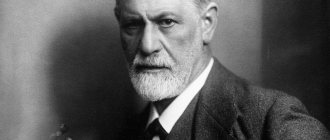Major discoveries
Freud made several fundamental discoveries in the field of psychology, introducing new trends and concepts. These include:
- Unconscious. By the Unconscious, Freud understood a special area of the psyche, the presence of which a person is not aware of. The unconscious seeks to subjugate the will and relieve the human individual from the pressure of moral standards.
- Libido. Freud called it the engine of the individual's mental life. Libido activity affects ambitions and aspirations. Freud draws a parallel between sexual and social activity: a man’s libido is stronger than a woman’s, so he has a stronger need for sex and a desire for competition.
- Interpretation of dreams. The unconscious constantly tries to overpower the will of the individual and sends him signals reminding him of suppressed desires. A person receives these signals in the form of dreams. To get rid of anxiety, you need to analyze dreams and find the true causes of discomfort.
- Neuroticism. Freud grouped mental disorders caused by suppression of impulses into one group and called them nervous diseases or neuroticism. All people existing within European culture are susceptible to neuroticism, since they are distant from nature and are forced to constantly control their natural needs.
Not all contemporaries welcomed Freud's ideas; some criticized them. Karen Horney, an American psychoanalyst, in one of her works examined in detail Freud's theory of women's envy of the male penis and suggested that in fact a man is jealous of the presence of a uterus and the ability to reproduce, and the driving force of the human personality is not libido, but anxiety. Karen's bold views made her one of the iconic figures of neo-Freudianism.
So what is psychoanalysis?
This is a specific therapy, a treatment method developed by Freud. It is presented in the form of communication between a patient-analysand and an analyst-psychologist. At the appointment , the patient lay down on the couch, closed his eyes and verbalized his thoughts, spoke out his dreams, fantasies, associations
- everything that his brain and subconscious are capable of.
For the duration of the session, Freud turned into the patient's father or mother and conducted a dialogue on their behalf. Thanks to this approach, it was easier for him to pull out grievances, forbidden attractions, aggression, anger and other hidden feelings of the patient. The psychologist called this process transfer. It took many patients years for it to happen. But in the end, if the psychoanalysis was successful, the patient got rid of neuroses, complexes, and negative thoughts.
“Therapy does not make a person happy, it only helps you feel less unhappy.”
, Freud wrote in his work The Discontents of Culture.
According to the psychoanalyst, what comes in dreams is the main cause of problems in reality. In this regard, dreams with sexual overtones were given great importance. The scientist called symbols and plots of dreams “the royal road to the unconscious.”
To learn more about patients, Freud invented the method of free association
. He showed a picture or said a word and asked the patient to name the first thing that came to mind. Based on the information received, the doctor made a conclusion about the analysand’s internal conflicts, which were the causes of his anxiety, psycho-emotional disorders, and other character problems.
Before Freud, people realized that they did not understand everything about their inner world and that mental disorders such as neuroses originated in the sphere of sexuality - what the psychiatrist called "libido."
According to the scientist, everyone has libido - sexual desire from birth. In infants, this is the “Oedipus complex”
: a newborn boy is drawn to his mother, he intends to take his father’s place next to her. When a child outgrows the Oedipus complex, he stops desiring his mother and begins to identify with his father - this is how a normal male character develops.
Personality
Initially, the idea of the human individual as a rational being was entrenched in philosophy. All actions were viewed as the result of a conscious decision.
This was the case before the discovery of the unconscious - a hidden component that guides the actions of an individual, but remains unconscious.
Freud suggested that the psyche of the individual is not whole. This is a structure consisting of separate parts:
- “I” is responsible for a conscious understanding of reality;
- “Super-I” - controls components formed under the influence of social norms;
- “It” stores repressed instincts and desires.
Every person has all the components. They constantly interact with each other. When he has any desire, the Conscious One evaluates it from the point of view of moral standards. If the fulfillment of a desire is fraught with a violation of these norms, it moves into the hidden part of the personality structure and remains there until it is satisfied. The more moral prohibitions an individual has (the stronger his will), the more unfulfilled desires he will have, hidden from the conscious outside the framework of the “It”. Constant control over one's aspirations causes neuroses - somatic manifestations expressed in physical and mental discomfort. Freudianism in philosophy made it possible to make significant progress in the study of one of the main issues of knowledge - the essence of man.
What are the most typical Freudian slips?
Freud's followers conducted many tests, studied a person's reaction to their reservations, revealing their hidden sexual overtones. To conduct one of them, they invited three groups of men, an attractive girl, and took a stun gun.
.
One
the group was greeted by a laboratory assistant in a short skirt and a translucent blouse, and the other two by a middle-aged professor. Participants in the experiment were asked to read certain pairs of words, one per second - these were expressions in which people often switch syllables. For example: not “a glass of champagne”, but “a glass of champagne”.
Following a sound signal, he had to name these phrases in turn. Now is the time to remember Freud, because what happened next is what he talked about. The men who met the seductive laboratory assistant made more blunders with sexual overtones in the spirit of: “naked howl” or “smooth sex” instead of “wash your hair” and “sweet cupcake”.
Participants of the third
The groups attached electrodes to their fingers that created weak impulses. They were told there was at least a 70% chance of getting hit, which was an outright lie. Here, too, they made a mistake, betraying their true thoughts that worried them at that moment: not “Kok Tolka,” but “Kok Kolka.”
When measuring the level of sexual anxiety, it turned out that it was higher among those who made the most reservations
with sexual overtones. Wanting to suppress the desire, the men were sentenced faster. This trap is called the “polar bear problem,” which was first noticed by writer Leo Tolstoy. He said that if you try your best not to think about something, that’s all that will be in your head.
Components of the psyche
The human psyche consists of the Conscious and the Unconscious. They are not equivalent: The unconscious tries to suppress consciousness and force the individual to follow his primary drives: Eros and Thanatos. Eros causes sexual desire, Thanatos – the need for death, one’s own and others’. If primary drives merge, a person becomes a maniac. He is unable to be guided by the principles of reality and sees the world as distorted, created to satisfy his desires. The need to achieve harmony between the components of the psyche forces him to commit murders and crimes of a sexual nature.
Secret society "The Committee"
The year 1910 brought discord to the team of followers and students of Sigmund Freud. The scientist’s opinion that psychological disorders and hysteria are the suppression of sexual energy did not find responses among the philosopher’s students, and disagreement with this theory led to controversy. Endless discussions and debates drove Freud crazy, and he decided to keep only those who adhered to the basics of his theory. Three years later, a virtual secret society arose, which was called the “Committee”. Sigmund Freud's life is full of great discoveries and interesting research.
Functions of the unconscious
“It” or the Unconscious requires a person to satisfy needs. The unconscious is guided only by internal desires, it is selfish and inconsistent. According to Freud, the main human desires are the desire to reproduce and power, the desire to experience pleasure and avoid feelings of fear. If a person is guided in his actions by the Conscious, the Unconscious comes into conflict with him. There is emotional tension that needs to be eliminated. To do this, the psyche uses the following techniques:
- Repression is the movement of desires into the “It” region, where they continue to influence the psyche, causing a feeling of unaccountable fear and anxiety.
- Rationalization - searching for a more acceptable explanation for true desires, eliminating feelings of shame.
- Sublimation - replacing instinctive drives with other activities: creativity, social work and others.
- Regression is a person’s refusal to perceive reality, a return to a stage of personality development that could provide psychological comfort.
The constant conflict between the Conscious and the Unconscious leads to mental disorders. The main goal of psychoanalysis is to determine a person’s true desires and find compromise ways to realize them.
What contributions did Sigmund Freud make to the development of psychology?
Sigmund Freud - Austrian psychoanalyst and psychiatrist.
He gained the greatest fame after
the discovery of psychoanalysis,
the discovery of which at one time greatly changed people's ideas about medicine, sociology and anthropology.
At the beginning of his scientific career, Freud deeply believed in the healing properties of hypnosis.
His fascination influenced Sigmund's thinking. But disappointment in this method forced the scientist to look for other ways. Trying to find a more advanced method, he used his own developed technique of free association, according to which the patient was asked to talk specifically without focusing on any topic suggested by the doctor. A person’s words should gradually lead to something more meaningful, which will help, firstly, to understand the essence of the problem, and secondly, to identify some reasons that would be very difficult to identify in any other way.
Freud's path to the discovery of psychoanalysis was difficult, unpleasant and sometimes even painful
.
Many friends and colleagues did not support his ideas and turned away from the scientist after his statement about the direct influence of sexual thoughts on hysteria and its manifestations. The statement was viewed with great skepticism. Around the same time, the scientist's father, Jakob Freud, died
, which was a real blow that drove Sigmund into despair.
Then he decided to apply the technique of free association to himself, where he examined his childhood memories, trying from a scientific point of view to understand the causes of his condition and find answers to tormenting questions. He finds some, but still remains dissatisfied with his research.
This dissatisfaction marked the beginning of psychoanalysis. But without finally achieving the desired result, Freud began to study dreams.
By examining his own dreams, Freud came to the conclusion that each element in a dream is the generated result of a whole series of hidden thoughts, which may not even be closely related and belong to different areas. In addition, associative thoughts do not go in order, as it might seem at first glance, but intersect and intertwine many times. He considered his work “The Interpretation of Dreams” to be his most important work. Freud could not find assistants who would want to study dreams. His friends and colleagues continued to be skeptical of Sigmund's tasks and solutions and underestimated his aspirations.
In addition, Freud made a major contribution by developing a three-component personality structure. (“It”, “I”, “Super-I”), where “It” is the basis for the manifestation of two other personalities, “I” is the human mind, his very personality, which controls processes in the psyche, and “Super-I” »
- inner voice.
Another important step in the development of psychology is the discovery of psychosexual stages of development
. Freud conducted research from the very beginning, when the body's methods of satisfaction are still infantile, to the end, when a person enters into sexual contact.
The scientist considered this discovery to be really important, because it is due to any violations during the passage of these stages that problems of a sexual, emotional and communicative nature appear in the future.
It is safe to say that after the discoveries made by Sigmund Freud, psychology reached a new level of development.
The origins of smoking addiction
Freud divided mental development into stages depending on the method of obtaining pleasure. He called the first oral - the stage of receiving pleasure using the mouth area. Babies, feeding on milk from the mother's breast, stimulate the oral cavity. In the process of satiation, they develop a feeling of satisfaction, and it is automatically associated with swallowing, chewing, and licking.
Freud believed that smoking addiction occurs in people who need to satisfy their needs, but have the ability to realize them. These people mentally return to the first stage of development and unconsciously strive to influence the oral cavity.
Freud once stated that women's addiction to smoking is a subconscious desire for oral sex. The scientist himself suffered from nicotine addiction, and his students immediately reminded him of this, hoping to confuse him. In response to this, Freud said his famous phrase, which later became a catchphrase: “Sometimes a cigar is just a cigar.”
Was Freud preoccupied or are these people prudes?
Now let’s remember the famous “Freudian slip”.
The scientist was sure that life is filled with associations with sex. A typical bigot will now begin to claim that only the preoccupied and idle are constantly thinking about such “animal things”, but this is not so.
The most common association: banana - erect penis - phallus. This trilogy created a stir in every country in the world where there are those who are not indifferent to Freud or have at least heard of him.
The psychoanalyst was accused of looking at the world through the glasses of sexuality
and generally “sexually preoccupied.” This cannot be ruled out either, but he imbued the analysis of dreams, paintings, and novels of the unconscious with sexual symbols.
Freud's contemporaries were less fortunate than us - their sex life could hardly be called happy, because in their times relations between the sexes were strictly regulated. Many prohibitions gave rise to anxious thoughts - sexual energy accumulated and settled inside.
If the relationship between a man and a woman was strictly regulated, then homosexuality and other “perversions” were generally taboo. But Freud and his students and supporters were the first to volunteer to change this.
Medical status allowed scientists to openly express a positive attitude towards such things
, in which they succeeded significantly, despite the moralists and bigots of those times (who probably also were not averse to letting go of their “correctness” and having a blast).
The role of culture
For Sigmund Freud, philosophy was a way of analyzing the influence of culture on humans. In his opinion, culture is an external censor of personality, defining norms and boundaries of what is permissible. The process of cultural development is directly related to a feeling of satisfaction. The evolution of culture alienates man from nature, the satisfaction of primitive instincts, and makes him unhappy.
Limiting natural desires causes feelings of guilt. Freud was convinced that culture suppresses man's natural desires for aggression and destruction. His colleague and follower Carl Jung at the beginning of his career agreed with Freud, but later changed his mind. Jung examined in more detail the influence of libido on a person and his desire for creativity. Based on Freud's teachings, Jung created his own theory about archetypes - images that are formed in the collective unconscious and influence people's perceptions.
Story
Freud's story began in the city of Freiberg, which today is called Příbor and is located in the Czech Republic. The future scientist was born on May 6, 1856 and became the third child in the family. Freud's parents had a good income thanks to the textile trade. Sigmund's mother is the second wife of Jacob Freud's father, who already had two sons. However, a sudden revolution destroyed the rosy plans, and the Freud family had to say goodbye to their home. They settled in Leizpig, and after a year they went to Vienna. Freud was never attracted to conversations about family and childhood. The reason for this was the atmosphere in which the boy grew up - a poor, dirty area, constant noise and unpleasant neighbors. In short, Sigmund Freud was in an environment at the time that could have had a negative impact on his learning.
Oedipus complex and Electra complex
Freud's concept of philosophy includes a deep analysis of human sexual desires. The scientist believed that they are formed in childhood and manifest themselves as the Oedipus Complex or the Electra Complex.
The description of the complexes was based on Freud’s observations of child-parent relationships and ways of showing affection in boys and girls. He found that boys pay much more attention to their mother, strive to hug or kiss her, and require constant attention. If a mother prefers to spend more time with her husband rather than with her son, the boy becomes jealous. Unconsciously, he experiences sexual cravings for his mother and perceives his father as a rival. Girls demonstrate attachment to their father and show a negative reaction to his attitude towards their mother.
What was special and revolutionary about Freud's ideas?
In the 19th century, few people thought about the inner world as a separate component influencing the present and future. But everyone knew that depending on the mood, the attitude towards what was happening changed.
Freud was the one who began to delve into the subconscious
, to understand what and how influences him - and he called this psychoanalysis.
Psychological theory and the influential treatment based on this theory have had a significant impact on medicine, psychology, anthropology, sociology, art and literature of the 20th century.
The methods and approaches of the psychoanalyst caused a resonance because they were innovative and were not perceived by conservatives
. However, there were others - people came to Freud for help and received it. Often this did not happen the first time, but session after session the patients got better and they got rid of their complexes.
Even though psychoanalysis has been and remains a controversial discipline, clear facts indicate that it works. The number of supporters and skeptics of Freud's theories has not diminished to this day. For many, his books and theories remain relevant in the 21st century.
Study period
At first, Sigmund was raised by his mother, but soon his father took over, who wanted a better future for him and in every possible way instilled in his son a love of literature. He succeeded and Freud Jr. retained this love until the end of his life.
Studying at the gymnasium
Diligence and ability to learn allowed Sigmund to go to school at the age of 9 - a year earlier than usual. At that time he already had 7 brothers and sisters . Sigmund's parents singled him out for his talent and desire to learn new things. To the point that the other children were forbidden to study music when he studied in a separate room.
At the age of 17, the young talent graduated from high school with honors. By that time, he was interested in literature and philosophy, and also knew several languages: German perfectly, English, French, Italian, Spanish, studied Latin and Greek.
Needless to say, during the entire period of his studies he was the number 1 student in his class.
Choice of profession
Sigmund Freud's further studies were limited due to his Jewish origin. His choice was commerce, industry, medicine or law. After some deliberation, he chose medicine and entered the University of Vienna in 1873.
At the university he began to study chemistry and anatomy. However, what he liked most was psychology and physiology. Ernst von Brücke lectured on these subjects at the university .
Sigmund was also impressed by the popular zoologist Karl Klaus , with whom he later carried out scientific work. During his time working under Klaus, "Freud quickly distinguished himself among other students, which allowed him to become a fellow of the Trieste Institute of Zoological Research twice, in 1875 and 1876."
Instincts as the driving force of behavior
Psychoanalytic theory is based on the idea that people are complex energy systems. In accordance with the achievements of physics and physiology of the 19th century, Freud believed that human behavior is activated by a single energy, according to the law of conservation of energy (that is, it can move from one state to another, but its quantity remains the same).[3] Freud took this general principle of nature, translated it into psychological terms, and concluded that the source of psychic energy is a neurophysiological state of excitation. He further postulated: each person has a certain limited amount of energy that fuels mental activity; the goal of any form of behavior of an individual is to reduce the tension caused by the unpleasant accumulation of this energy. For example, if a significant part of your energy is spent on comprehending the meaning of what is written on this page, then it will not be enough for other types of mental activity - daydreaming or watching a television program. Likewise, your reason for reading this may be to relieve the stress of taking an exam next week.
Thus, according to Freud's theory, human motivation is based entirely on the energy of excitement produced by bodily needs. In his opinion, the main amount of mental energy generated by the body is directed to mental activity, which allows one to reduce the level of excitement caused by need. According to Freud, mental images of bodily needs, expressed in the form of desires, are called instincts. Instincts manifest innate states of excitation at the level of the body, requiring release and discharge. Freud argued that all human activity (thinking, perception, memory and imagination) is determined by instincts. The influence of the latter on behavior can be either direct or indirect, disguised. People behave in one way or another because they are driven by unconscious tension - their actions serve the purpose of reducing this tension. Instincts as such are the “ultimate cause of all activity.”
Any instinct has four characteristics: source, goal, object and stimulus. The source of instinct is the state of the body or the need that causes this state. The sources of life instincts are described by neurophysiology (for example, hunger or thirst). Freud did not give a clear definition of the death instincts. The goal of instinct is always to eliminate or reduce the excitement caused by the need. If the goal is achieved, the person experiences a short-term state of bliss. Although there are many ways to achieve an instinctive goal, there is a tendency to maintain the state of arousal at some minimum level (according to the pleasure principle).
Object means any person, object in the environment, or anything in an individual's own body that provides satisfaction (i.e., purpose) to an instinct. The actions that lead to instinctive pleasure are not necessarily always the same. In fact, an object can change throughout life. In addition to flexibility in the choice of objects, individuals are able to postpone the discharge of instinctual energy for long periods of time.
Almost any behavioral process in psychoanalytic theory can be described in terms of: 1) binding, or directing energy to an object (cathexis); 2) an obstacle that interferes with the satisfaction of instinct (anticathexis).[4] An example of cathexis is emotional attachment to other people (that is, the transfer of energy to them), passion for someone’s thoughts or ideals. Anticathexis manifests itself in external or internal barriers that prevent the immediate weakening of instinctual needs. Thus, the interaction between the expression of instinct and its inhibition, between cathexis and anti-cathexis constitutes the main bastion of the psychoanalytic construction of a motivation system.
Finally, the stimulus represents the amount of energy, force, or pressure that is required to satisfy the instinct. It can be assessed indirectly by observing the number and types of obstacles that a person must overcome in pursuit of a particular goal. [5]
The key to understanding the dynamics of instinctual energy and its expression in the choice of objects is the concept of displaced activity. According to this concept, the release of energy and the release of tension occurs through a change in behavioral activity. Displaced activity occurs when, for some reason, the choice of the desired object to satisfy the instinct is impossible. In such cases the instinct may shift and thus focus its energy on some other object. Consider the following situation. The boss intimidated you with the measures that will follow if you don’t do your job. You come home, slam the door, kick the dog, and yell at your spouse. What happened? You took out your anger on objects that are not directly related to your condition; it was an indirect expression of emotion.
Freud believed that many socio-psychological phenomena can be understood in the context of the displacement of two primary instincts: sexual and aggressive. For example, the socialization of a child can be partly explained as the result of a successive shift of sexual needs from one object to another, as required by parents and society. In a similar way, racial prejudice and war can be explained by the displacement of aggressive impulses.
Thus, according to Freud, the entire structure of modern civilization (art, music, literature) is a product of the displacement of sexual and aggressive energy. Unable to receive pleasure directly and immediately, people learned to shift their instinctual energy to other people, other objects and other activities, instead of those intended for direct release of tension. Thus, complex religious, political, economic and other institutions emerge.
Family and Children
For decades, the scientist had no contact with women; one might even say that he was afraid of their company. This strange behavior caused a lot of jokes and speculation, which put Freud in awkward situations. The philosopher has long argued that he can do just fine without female interference in his personal space. But Sigmund still could not escape the feminine charm. The love story is quite romantic: on the way to the printing house, the scientist almost fell under the wheels of a carriage; the frightened passenger, as a sign of apology, sent Freud an invitation to a ball. The invitation was accepted, and already at the event the philosopher met Martha Beirnais, who became his wife. All the time from the engagement to the beginning of their life together, Freud also communicated with Martha’s sister Minna. Because of this, there were frequent scandals in the family; the wife was categorically against it and convinced her husband to stop all communication with his sister. The constant scandals tired Sigmund, and he followed her instructions.
Martha gave birth to Freud six children, after which the scientist decided to completely abandon sex life. Anna was the last child in the family. It was she who spent the last years of his life with her father and after his death continued his work. A London children's psychotherapy center is named after Anna Freud.
Facts from the life of a scientist
In addition to great achievements, the biography of the scientist is full of many interesting facts:
- Freud avoided the numbers 6 and 2, thus he avoided the “hell room”, number 62. Sometimes the mania reached the point of absurdity, and on February 6 the scientist did not appear on the streets of the city, thereby hiding from the negative events that could happen on that day .
- It's no secret that Freud considered his point of view the only correct one and demanded utmost attention from the listeners of his lectures.
- Sigmund had a phenomenal memory. He had no problem remembering any notes or important facts from books. That is why learning languages, even such complex ones as Latin, was relatively easy for Freud.
- Freud never looked people in the eye; many people focused their attention on this feature. There are rumors that it was for this reason that the famous couch appeared in the psychoanalyst’s office, which helped to avoid these awkward glances.
The publications of Sigmund Freud are the subject of discussion in the modern world. The scientist literally revolutionized the concept of psychoanalysis and made an invaluable contribution to the development of this field.
Other methods of Z. Freud
Freud later develops a method for analyzing dreams. It is with the help of them, as he argued, that the human problem can be solved. People dream dreams on purpose, in this way consciousness transmits a signal and helps to find a way out of the current situation, but people, as a rule, do not know how to do this on their own. Sigmund Freud began to receive patients and interpret their dreams; he listened to the most intimate secrets of his acquaintances and complete strangers, increasingly realizing that all difficulties were related to childhood or sexual life.
Such premises were again not liked by the community of psychoanalysts, but Freud began to develop the doctrine further.
last years of life
Unfortunately, Sigmund Freud's subsequent life was filled with tragic events. In 1933, the Nazis came to power in Germany, Jews began to be persecuted, and Freud's books were burned in Berlin. It got worse - he himself ended up in the Vienna ghetto, and his sisters in a concentration camp. They managed to rescue him, and in 1938 he and his family left for London. But he had only a year to live: he suffered from oral cancer caused by smoking.
On September 23, 1939, Sigmund Freud was injected with several cubes of morphine, a dose sufficient to terminate the life of a person weakened by illness. He died at 3 am at the age of 83, his body was cremated and his ashes were placed in a special Etruscan vase, which is kept in the Golders Green Mausoleum.
The last days of the great scientist
The scientist spent the best years of his life in constant search and work. Freud's death shocked many. The man suffered from pain in the throat and mouth. A tumor was later found, due to which he underwent dozens of surgeries, losing the pleasant appearance of his face. Over the years of his life, S. Freud managed to make important contributions to many areas of human life. It would seem that with a little more time, he would have created much more.
But, unfortunately, the disease took its toll. The man made an agreement in advance with his attending physician, and when he no longer wanted to endure it, and there was no need to force all his relatives to watch this, S. Freud turned to him and said goodbye to this world. After the injection, he calmly fell into an eternal sleep.
After university
opened a doctor’s office in 1881 and began treating psychoneuroses. Soon after this, he began to use cocaine for medicinal purposes, first trying its effects on himself.
Colleagues looked at him askance, some called him an adventurer. Subsequently, it became clear to him that cocaine could not cure neuroses, but it was quite easy to get used to it. It took Freud a lot of work to abandon the white powder and gain the authority of a pure doctor and scientist.











